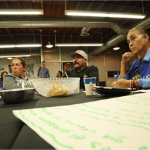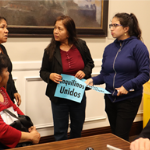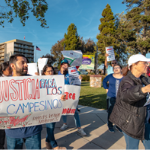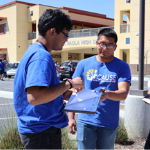More Victims of the California Wildfires: Avocados and Lemons

The fire that rampaged through the Brokaw Ranch in Ventura County last week was fast, furious and unstoppable, driven by winds gusting at 70 miles an hour.
Flames raced through the chaparral, setting ablaze 60-foot-tall trees whose burning embers flew into the heart of the avocado orchard.
“We lost about 80 percent of our avocado crop,” said Ellen Brokaw, whose family farms 200 acres in Santa Paula and supplies restaurants and national supermarket chains.

It is too early to know the full extent of the damage because much of the wildfire zone is still closed off or enveloped in haze. The fire is capricious and, as with the structures that it damaged, its flames often hurtle through one stretch of land while jumping over an adjacent plot.
Avocado orchards are particularly vulnerable: They line hillsides, which were in the path of the fire, and their dropped leaves collect on the ground, providing perfect tinder.
Lemon groves tend to be located on flatter ground, and the trees do not shed their leaves. But they were battered by the same winds that spread the fires, blowing loose or badly scarring the fruit. Lemons cannot be sold once they have hit the ground, and damaged lemons suffer in quality and value.
“It will take days, weeks or longer to assess the loss,” said John Krist, chief executive of the Ventura County Farm Bureau. “What we know is, there’s a lot of fruit on the ground.”
Consumers are unlikely to see a surge in the price of avocados from the fire because most avocados bought in the United States are grown in Mexico. A spike in lemon prices is unlikely to occur even though Ventura County produces more than 40 percent of the national output, Mr. Krist said, because any lost crop can be made up by increasing imports.

Still, the wildfires happened just before some growers planned to start harvesting their avocados and lemons. And farmers who are relieved their entire crop was not wiped out are still worried about having enough workers when they will need them later in the season, because it is still unclear how many people lost their homes.
“Everything has been thrown up in the air,” said Lisa Churchill, who grows avocados and specialty tangerines, like the pixie variety, in the Ojai Valley. Ms. Churchill said she believes she lost about half of her avocado crop and about 20 percent of her mandarins. “We don’t know what impact this will have on our ability to put together a crew,” she said.
Many farmers said the devastation would have been considerably worse were it not for the workers on the front lines, frenetically spraying water from hoses and small water tanks mounted on their backs. Sometimes workers resorted to shoveling sand onto smoldering vegetation.
Some 36,000 farmworkers, the majority of them immigrants, work in Ventura County. About nine out of 10 farmworkers in the area are illegally in the country, according to independent estimates.
One Mexican worker, who gave only his first name, Fermin, evacuated his wife and 5-year-old daughter from their trailer park, then went to the farm where he works.

“The fire was all around us, and I felt despair and sadness for my boss and the land as I saw it approaching,” Fermin explained in Spanish during a break from clearing debris and repairing melted pipes.
Fermin and his co-workers fought the blaze until firefighters arrived and ordered them to leave. He and others were back on the job at sunrise the next morning, according to his supervisor, Mike Sullivan, who manages several hundred acres of orchards for ranchers in the area.
Over the last few months, natural disasters have damaged other signature crops. The grape harvest was nearly complete when wildfires hit Northern California in October, but some growers are anxious about whether the taste of their wine could be tainted by smoke.
Hurricane Irma in September inflicted more than $760 million in damage to Florida’s citrus groves. Adam Putnam, the Florida agriculture commissioner, said on Tuesday that citrus growers were still struggling with the devastation that has decimated this year’s production.
In southern Florida, tomato growers have faced delays and lower early yields because of the storm. And destruction to worker housing forced many field hands to double up in available units, according to Julia Perkins of the Coalition of Immokalee Workers, a labor-rights group.

Thanks to its mild climate and rich soil, Ventura County produces a variety of crops all year. In the plains around Oxnard, Calif., the vast strawberry fields have been spared from the fires. But thousands of immigrants toiling in the fields initially lacked masks to protect them from the thick, acrid smoke that wafted across the county.
Volunteers have descended on the fields to hand out masks since last week. “We have been moving mask distributors up and down the coast,” said Lucas Zucker, policy director of the Central Coast Alliance United for a Sustainable Economy, known as Cause.
The California Strawberry Commission has urged workers to wear masks, and some growers have distributed them. One 44-year-old farmworker from Mexico who gave his name as Alfonzo said he worked without a proper mask before Cause gave him one. “My throat was aching, but I have my family to support and the rent to pay,” said Alfonzo, who earns $10.50 an hour in the fields.
Ventura County growers are used to Santa Ana winds, and many have lost crops before, mainly to frost. But they said they were surprised to see wildfires so close to the ocean and so late in the year, which highlights the severity of a yearslong drought.
“This is a complete game-changer for a lot of us,” said Leslie Leavens, a fourth-generation farmer whose family grows avocados and lemons on 800 acres in Ventura Country.
As for Ms. Brokaw, she said she was confident that the majority of her trees would survive, even if there are barely any avocados for her to sell this year. “The orchard can be rejuvenated,” she said. “We are committed to this, long-term.”















